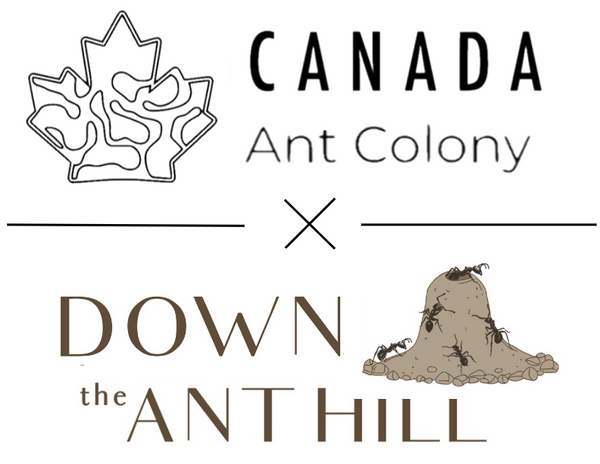Likely brought over during Canada’s colonisation and discovery in the 1800’s, the infamous European fire ants have been ruling north american lawns ever since. A widely distributed, common European species of ants that are known for their voracious appetite and painful sting. These ants have adapted so well they managed to survive the harsh Canadian winters and have propagated themselves all over north america.
If you're looking for colonies of European Fire Ants, check them out here!

Myrmica rubra (European Fire Ants) often build extensive supercolonies across meadows and forests.
Taxonomy
-Familia: Formicidae
--Subfmilia: Myrmicinae
--Tribus: Myrmicini
----Genus: Myrmica
Species: Myrmica rubra
Basic information
Origin: Great Britain to Central Asia, Skandinavia to the black sea. Introduced to North America (Canada, from where they spread to the United States)
Habitat: Enjoys warm temperatures but doesn’t necessarily need them, I have kept them in an air-conditioned room and they have done just fine. They enjoy a very moist nest with a good amount of darkness.
Colony form: Polygynous, but can also found with a single queen, has macrogynes and microgynes (see below)
Colony size: up to 20.000 workers
Colony age: 15 years for individual queens, colonies can adopt additional queens to extend their lifetime
Founding: semi-claustral, adoption, budding off satellite nests
Workers: monomorphic
Nesting: These ants dig nests into dirt and often burrow quite deep. (at least a foot). They prefer places in the shadows, often under stones or rubble. Can pile up quite impressive hills when nesting on flat meadows.
Hibernation: October - March, requires at least 3 months of hibernation in 4-6 degrees celsius.
Feeding: Trophobiosis, Zoophagy (liquid sugars and arthropods)
Reproduction: Sends out alates in August and September, usually during the morning hours and the late afternoon.
Appearance
Workers: They have a red head with light maroon thorax. Gaster is red with a shiny tint. They also have black/brown legs.
Queen: Brown or red heads with a light brown thorax. Gaster is vibrant red and has an orange undertone. Also has a shiny tint on gaster.
Drone: Dark brown head with light brown thorax. Gaster is red and the legs are semi-transparent.
Size
Workers: 4-6mm long
Queens:
*Macrogyne: 7,5 - 8,5mm *Microgyne: 6,5 - 7,5mm
Drones: 4 - 6mm
Development time at 75°F/24°C
Egg to larvae: around 10 days
Larvae to pupa: around 8 days
Pupae to worker: Around 10-12 days
Egg to worker: 28-30 days
Ant keeping information
Recommended for beginners: Sort of. Great for intermediates. Challenging but a great deal of fun to watch hunt. The most improtant thing is to make sure their nesting space is always moist so the ants and their brood don't dry out.
Temperature: 14 - 29° Celcius
Nesting materials: Nests in dirt and rotting wood.
Temper/Behaviour
These ants are quite curious, they always investigate a sound or smell. I find they often leave the nest in packs and are most active during the day.
Myrmica rubra are active hunters, they are super aggressive and have a potent stinger they use when swarming their prey. It is very enjoyable to keep these ants because they always give you something to see, especially in polygynous colonies.
Additional antkeeping information
Myrmica rubra is the most common and ecologycally most important Myrmica species in Europe.
Most Myrmica species have macrogynes and microgynes, they're essentially big queens and small queens. There's usually only one macrogyne in a colony while microgynes have a strong tendency towards polygyny. New studies have shown that the microgynes of Myrmica rubra are actually genetically different from the macrogynes and most likely represent an emerging parasite species that has no yet fully completed it's ascendence to an individual species.
The workers love sugars and will create large-scale trails to sugar sources.
Myrmica Rubra are very interesting to watch hunt. They are constantly active, quickly swarm food items and use their stingers to paralyze and kill their prey.
Workers can sting with an effect similar to a nettle plant.
Shows high intraspecific competiton with large-scale extremination campaigns and the winning side plundering the enemy nest.
Extra tip: If you’re putting them into a natural set up, put your lighting outlet near the glass to produce heat and they will nest beside it.
Diet
Sugars
Myrmica Rubra love honey and sugar water. From my experience, they don’t find too much interest in fruits at all.
Protein
As for protein, they love nearly anything you give them. But they love hunting fruit flies.
This guide was compiled and written by Daniel Cantin of the 'Ants and Antkeeping' discord server, which can be found here. https://discord.gg/YbZGvtR3
This guide has been posted with the permission of the authors. The original article may be found here. I have also made some edits based on my own observations
